In the mid 19th century, northern Europeons began settling into the area between what is now known as Pyramid Point and Glen Arbor, along the shores of Sleeping Bear Bay. Thomas Kelderhouse, the owner of several cargo ships on Lake Michigan, realized the potential of the area’s timber during a stopover on South Manitou Island. He made a deal with a local landowner on the mainland, Carsten Burfiend, where Kelderhouse would build a dock if Burfiend would donate the property adjacent to it. The resulting port was named after the one of the first ships to arrive, the S.S. Oneida.
Over time, the land was cleared of it’s timber and farmed. The sandy soil wasn’t the best for crops, but the longer growing season along Lake Michigan helped sustain the community for a time. Eventually, most of the buildings were abandoned. When the National Park Service first acquired Port Oneida in the 1970’s, the policy was to remove the buildings and let nature retake the land. Fortunately, the funds weren’t available at that time to remove the structures. Eventually that policy was changed, after the public realized that the county roads were going to be removed also….thereby eliminating access to the area beaches. As a result of it’s time in limbo, Port Oneida is one of the largest examples of a pre-modern rural community in the United States. The buildings are now being preserved, as is the history of those early settlers.
Each August, the National Park Service partners with the nonprofit Preserve Historic Sleeping Bear for the Port Oneida Fair. The event showcases rural life as it would have been in the late 1800’s and early 1900’s. This year’s fair was held over two days, up from the usual one day event. Admission is free, although a park pass is required to be on the grounds.
Spread over five seperate farms, there were many different demonstrations as to how things were done in the past. Above, a man rides in a horse drawn buggy across a field at the Dechow farm.
Oxen in their yolks, ready to do some work in the fields!
A young boy using a shaving horse and a spoke shave to shape a piece of wood.
This woman was demonstrating the art of spinning wool. She was really good at it. 🙂
This display from the Empire Area Museum had two hand-cranked phonographs; the one on the right was an Edison. A far cry from listening to music on your iPhone. 😀
There were several bicycles on display. This one was actually a predecessor to the high wheeler.
We found this oil-burning headlight to be interesting. Note the red lens on the left side. The right side is green, just like a boat would have.
This little McCormick-Deering gasoline engine was chugging along. It was connected to a water pump. They had several examples of old engines, one of which was powering a Maytag washing machine.
A pair of beautiful draft horses. The front one is a Belgian and the one behind is a Percheron.
Just across M-22 from the Dechow farm is the Olsen farm.
This home is the showcase of Port Oneida. It doubles as an information center for the historic district.
This gentleman was playing a hammer dulcimer. To me, they are one of the prettiest sounding musical instruments ever made.
This man was explaining the uses of the flax plant. In his hand was a by-product of the processing of flax, called tow fibers. This was timely for us, as Diana had just mentioned earlier this week that she wondered where the term ‘tow head’ came from for blondes. Well, he explained that the term came from the similarity of the color of the fibers to blonde hair. He also told us that the fibers were used to make rope, hence the term ‘tow rope’….and towing your car, and so on. Pretty cool. 🙂
The woman with him was spinning tow. Both of them were wearing clothes made from tow. Sorry about the angle of the photo: that’s a fiber spindle, not a flute. 🙂
From the Olsen farm, we continued down the road to the Burfiend Barn.
Outside the barn, children and adult volunteers were making wooden barn pegs. They drove the wood through cylindrical tubes with wooden mallets. Each new peg drove the last one out of the tube.
Inside the barn, the string band Carter Creek was putting on a show. We really enjoyed listening to them, especially when they played an old favorite of ours…John Prine’s ‘Paradise’.
We really enjoyed our day at the Port Oneida Fair. If you are ever visiting Sleeping Bear National Lakeshore the second Saturday in August, be sure to save the afternoon for this event.
————————————-
Click here to shop exploRVistas Amazon link
————————————-
explorRVistas is a participant in the Amazon Services LLC Associates Program, an affiliate advertising program designed to provide a means for sites to earn advertising fees by advertising and linking to Amazon .com. Shopping through our link doesn’t add anything to your cost, but it does help support this blog. Thank you for shopping through exploRVistas!

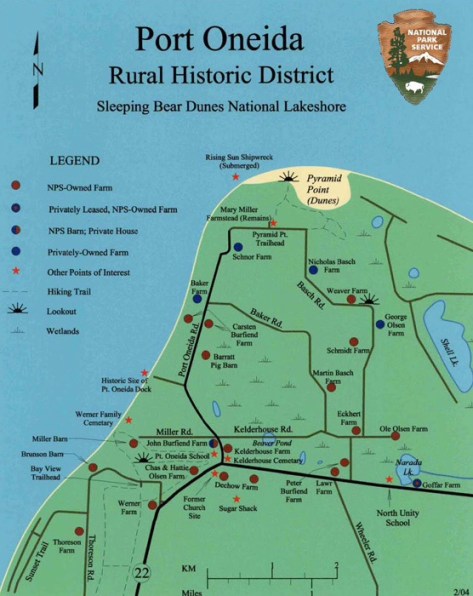
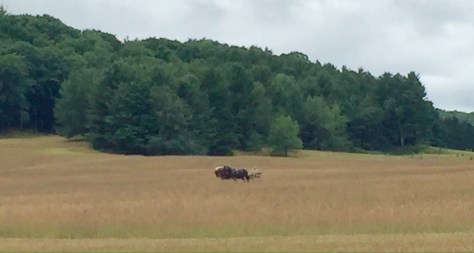

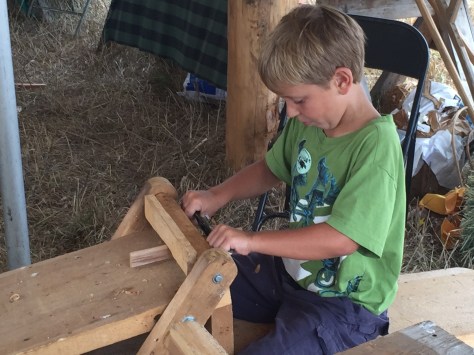
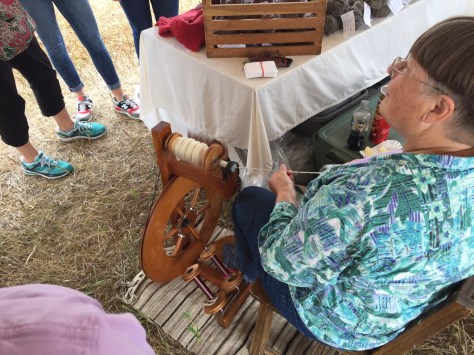

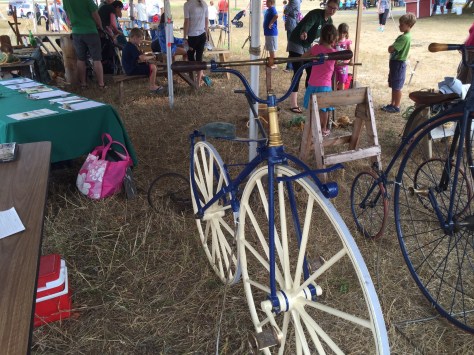
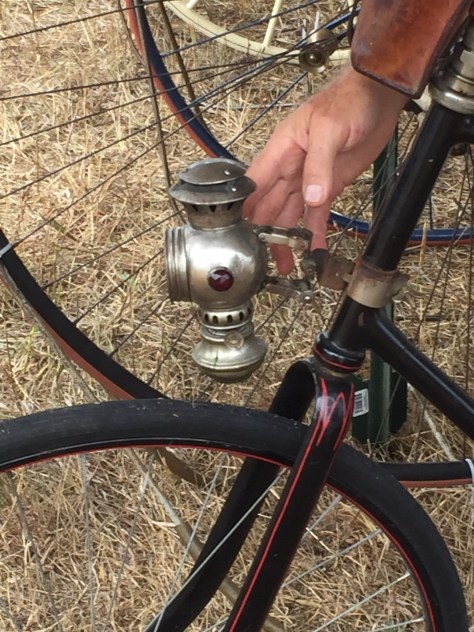
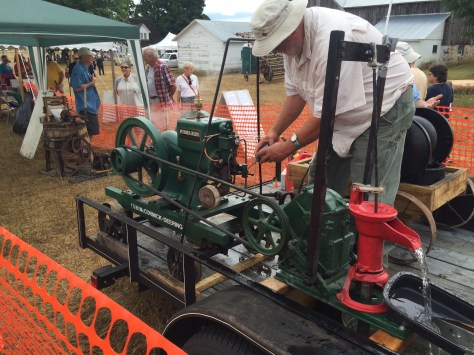
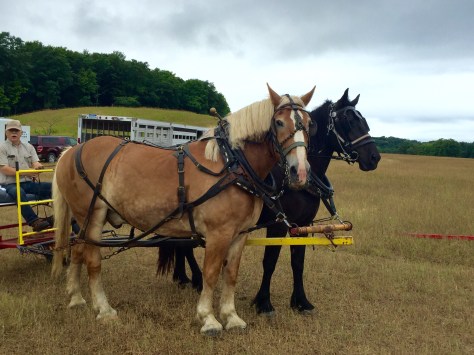
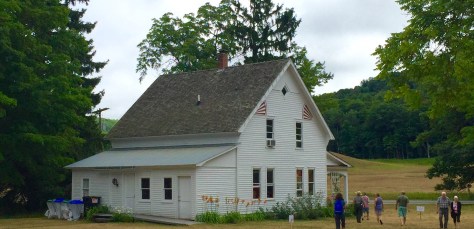

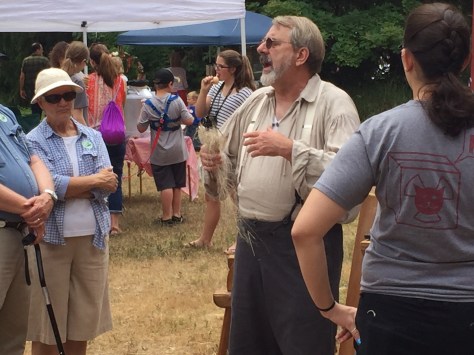
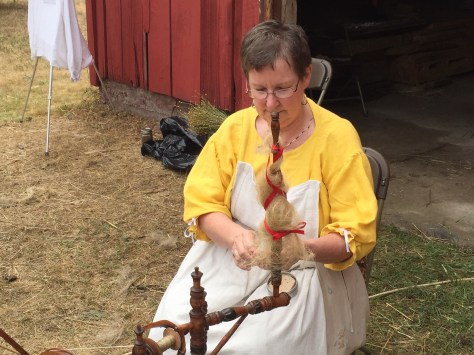
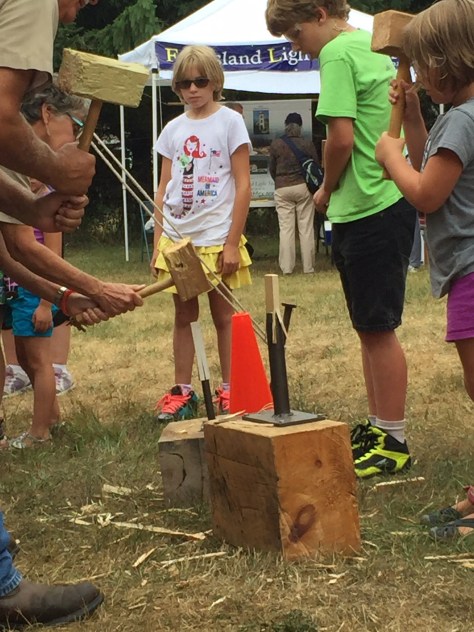
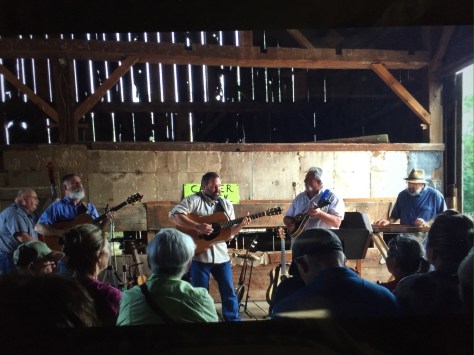
I love when they show us how to use old tools, it’s always fascinating !
LikeLiked by 1 person
I agree, Gin! Are you still able to find any farmers using these methods in England?
LikeLiked by 1 person
Reenactment is a big thing here (for different periods), and there are a lot of people that try to maintain the traditions, do shows and demonstrations for kids and adults. In museums, you can find these kind of display and people can try etc
In Belgium, the horse like the one you saw are quite popular. People have them for show to display the old techniques. In Belgium there is a massive show, that started in 1926, that focuses on farming techniques, one of the biggest event in Europe : http://www.foiredelibramont.be/index.php?lang=en
Some artisans still use old technique (especially glass blowing or pottery).
I just love these kind of displays, it’s so impressive.
LikeLiked by 1 person
Thanks for the link, Gin! It’s great to see these traditions being kept alive. 🙂
LikeLiked by 1 person
Those demonstrations are always so interesting. I hope they’re teaching young people how to use them with precision -especially the musical instruments – so that the skill isn’t lost. Glad that lack of funding turned out to be a good thing for a change 🙂 Those oxen are beautiful!! Very cool about the tow and how it evolved to a term we use every day.
LikeLiked by 1 person
Yes, coming away from the fair knowing the story behind tow pretty much made our day, Jodee. 🙂
LikeLike
Even though we’ve been to the area twice, this was new to me. Great background information. We really enjoy living history. Interesting to learn about the word “tow.” Tow head makes a lot of sense now:) I did do a double take at the spinning wheel:) Thanks for sharing:)
LikeLiked by 1 person
I took all those photos with my iPhone, and I noticed the woman and her spinning wheel flute when I got back to our RV, Pam.
We went to the festival back in 2013 and really wanted to get there again this year. Last year’s fair was cancelled because the NPS workers were all busy cleaning up DH Day campground and Alligator Hill after the big storm.
LikeLiked by 1 person
Taking time to enjoy the parks is one of the perks of this type of travel. What a good way to spend your day.
LikeLiked by 1 person
Most definitely, Debbie!
LikeLike
Very interesting to get a glimpse of what life must have been like back then. Thanks for sharing!
LikeLiked by 1 person
Quite a bit different than the farm work you did last year, Jim!
LikeLike
Great post, Jim. When we are in Michigan next summer we may be able to see it for ourselves.
LikeLiked by 1 person
This would be right up your alley, Bob. So much history!
Tip on Wild Cherry: the park was packed all of July and most of August. If you are coming, make reservations early.
LikeLike
Very interesting!
LikeLiked by 1 person
Thanks, Kelly! 🙂
LikeLiked by 1 person
Good posts, beautiful blog.
Congratulations.
Welcome to see my creations:
http://paintdigi.wordpress.com
LikeLiked by 1 person
Thank you! I will check them out.
LikeLike
you welcome
LikeLiked by 1 person
Fabulous to take a walk back in time. I must say some of the items i have seen in use in my growing up years. I believe that makes me rather ‘mature’. 🙂
LikeLiked by 1 person
Me too, but coming from Detroit, the rural items were new to me, Sue. 🙂
LikeLike